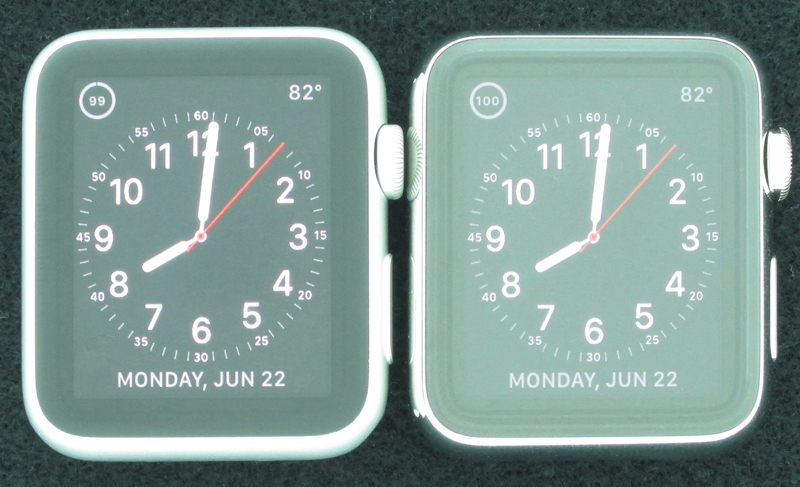The Photo below is a side-by-side screen shot of the Apple Watch Sport with Ion-X Glass on the left, and the Apple Watch with Sapphire on the right. They were taken together simultaneously inside an Integrating Hemisphere that provides a very uniform light distribution coming from all directions. The watches are sitting on a dark black background. See the Caption below for a detailed explanation of the Photo.

There are a number of important but subtle details that we will explain first. The Apple Watch on the right has a mirror stainless steel finish, so the lower portion of the case appears dark in the photo because it is providing a mirror reflection of the black background. The Apple Watch Sport on the left has anodized aluminum with a matte finish that diffusely reflects light from all directions and therefore has a more uniform appearance. So if you don't look closely it looks as if the Apple Watch on the right is smaller, but it's just an optical illusion from the differing brightness reflections from the cases. Also note that the mirror finish of the watch on the right is reflecting the Digital Crown and Side Button of the watch on the left.
In the dark both watches appear identical. The OLED displays have a perfect all black background, with white text and graphics, and a vibrant saturated red second hand.
The screen shot Photo above was taken at an ambient light level of 2,000 lux, which corresponds to moderate outdoor lighting in the shade or an overcast sky. Indoor residential lighting typically ranges from 100 to 500 lux, while office, commercial, and task lighting typically ranges 500 to 1,500 lux. Full Daylight that is not in direct sunlight ranges from 10,000 to 25,000 lux, while direct sunlight is 120,000 lux. To see how other displays perform in up to 40,000 lux see this article on Displays in High Ambient Light.
In the Photo above the ambient light penetrates and reflects from different layers in the display so some of its internal structures are visible. The OLED display itself is the inner rectangle in both watches. The background is much brighter on the right Sapphire display due to its 74% higher Reflectance compared to the Glass display on the left. The reflected ambient light reduces the image contrast of the white text and graphics, and also the color saturation and vibrancy of the red second hand. The large differences between displays are very obvious and striking.
Finally, on a technical note, the slight green tint visible in the photo for the Apple Watch with Sapphire on the right is due to a variation in its Reflectance Spectrum for ambient light, which is stronger in the green portion of the spectrum and weaker in the red and blue portions of the spectrum compared to the Apple Watch Sport with Glass display on the left. It is unlikely to be noticeable except possibly in high ambient light that is itself neutral in color. This effect does not occur with pure sapphire, so it is most likely due to something in the optical bonding and lamination of the sapphire to the OLED display.